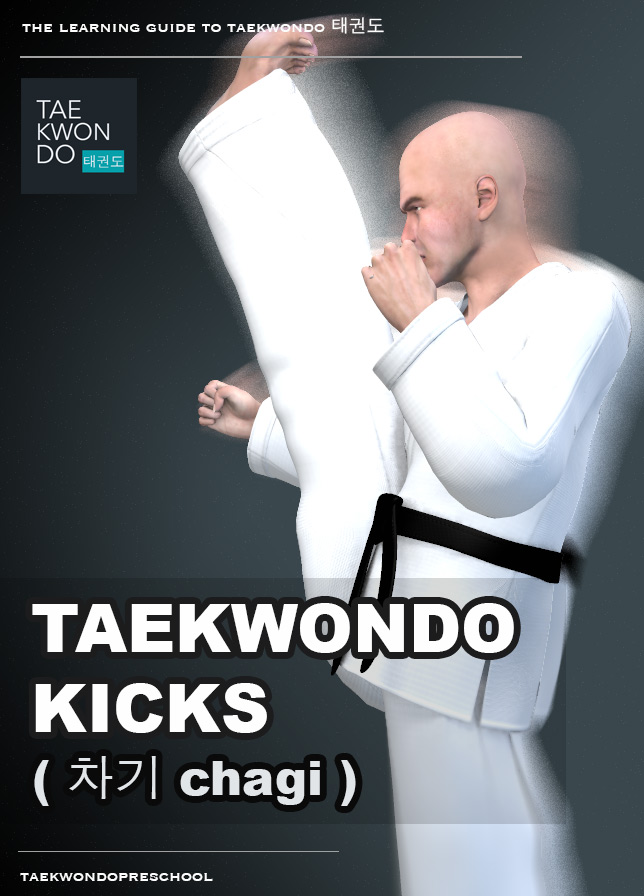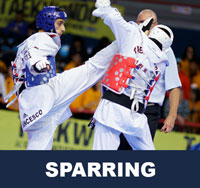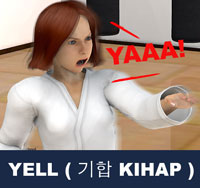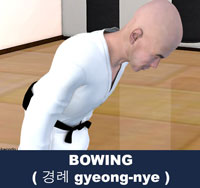Taekwondo 태권도Taekwondo Preschool
Promotion from one geup to the next can proceed rapidly in some schools, since schools often allow geup promotions every two, three, or four months. Students of geup rank learn the most basic techniques first, and then move on to more advanced techniques as they approach first dan. Many of the older and more traditional schools often take longer to allow students to test for higher ranks than newer, more contemporary schools, as they may not have the required testing intervals. View Taekwondo belt levels »
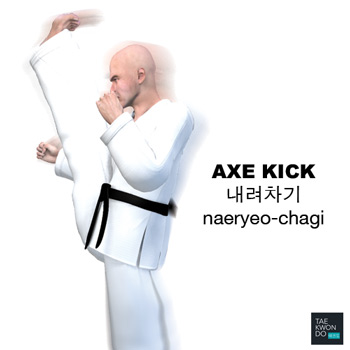
Axe Kick
내려차기 naeryeo-chagi
A kick (차기 chagi) is a physical strike using the foot, leg, or knee. The striker relaxes to the extent possible during the strike, tensing the muscles of much of the body only at the time of impact, then relaxing again to recoil the striking part. Relaxation enables the strike to achieve the greatest possible velocity during travel, while rigidity at impact allows the maximum transfer of force.
Difficulty Level: Beginner Technique: Kick ( 차기 chagi )
The Axe Kick ( 내려차기 naeryeo-chagi ) is a beginner kick ( 차기 chagi ) that is popular due to taekwondo tournament sparring ( 겨루기 gyeorugi ) competitions. The kick ( 차기 chagi ) is also known as the hammer kick, stretch kick, or thigh of obliteration kick because it is characterized by a straightened leg descending onto an opponent like the blade of an axe or like the motion of a hammer on a nail.
In usage, the kick ( 차기 chagi ) is commonly seen during sparring ( 겨루기 gyeorugi ), breaking ( 격파 gyeokpa ), self-defense ( 호신술 hosinsool ), stretching, promotion test, and demonstration events. This is a kick ( 차기 chagi ) that a practitioner should practice often and master. Practice is the act of rehearsing a behavior over and over, or engaging in an activity again and again, for the purpose of improving or mastering it, as in the phrase 'practice makes perfect'.
The upward arc motion is stopped at the peak, and then the attacking foot ( 발 bal ) is lowered with extreme violent downward force so as to strike the target from above. When striking the target, the attacking leg could be straight down or bent in a whipping motion downward, unlike the crescent kicks where its from the side. It is common to slightly bend the knee ( 무릎 mureup ) of the leg one is standing on when performing the Axe Kick ( 내려차기 naeryeo-chagi ), and pointing the standing foot ( 발 bal ) somewhat slightly outwards for balance.
The kicking surface could be the back of the heel ( 뒤꿈치 dwikkumchi ), bottom of the heel ( 뒤축 dwichuk ), or even the sole area of the foot ( 발바닥 balbadak ). The kick ( 차기 chagi ) is typically targeted toward the opponent's head ( 머리 meoli ), shoulder ( 어깨 eokkae ), and collarbone ( 쇄골 swaegol ) area, and requires significant flexibility to employ effectively.
The Axe Kick ( 내려차기 naeryeo-chagi ) can be a knock-out blow to the opponent if one achieves proper penetration in maximizing the damage at the point of impact to the opponent's head ( 머리 meoli ). Strikes should aim for a point 4–6 inches (10–15 cm) behind the target surface, to impart the most energy into the target. The striker in combat should attempt to strike through the target area, not just contact the surface.
As in all taekwondo kicks, one will also try to get ones 'hip into the kick', resulting perhaps in a slight shift of weight forward for more power and distance. In any case, this is a linear kick, and as such one that one can get ones weight behind. A common error among beginners is trying to lift too high the kick ( 차기 chagi ), and by doing so, they overdo the kick ( 차기 chagi ) slipping backwards and falling, or pulling their hamstrings ( 햄스트링 haemseuteuling ) to injure themselves.
Taekwondo practitioners may include a shout or yell ( 기합 kihap ), to help tense the muscles at impact and distract or frighten the opponent. Practitioners generally exhale as the kick nears the target. Breath control is also important to relax the body when not attacking; novice practitioners often waste significant energy because they are tense at inappropriate times.
Variations of Axe Kick ( 내려차기 naeryeo-chagi )
- Front Foot Axe Kick ( 앞발 내려차기 apbal-naeryeo-chagi )
- Skipping Axe Kick ( 발붙여 내려차기 balbucheo-naeryeo-chagi )
- Jumping Axe Kick ( 뛰어 내려차기 ttwieo-naeryeo-chagi )
Training Methods
How well one improves with training depends on several factors, such as the frequency it is engaged in, and the type of feedback that is available for improvement. If a student does not train often enough, reinforcement fades, and he or she is likely to forget what was learned.
During training, taekwondo practitioners may use various equipment and gear for practicing the kick ( 차기 chagi ). Taekwondo extensively uses the heavy bag for developing power and endurance. Powerful strikes to the heavy bag aren't recommended for inexperienced, or younger athletes, as risk of sprain, strain, or bone plate damage may adversely affect bone structures. It is highly recommended to carefully focus strikes to reduce chance of injury.
The kick ( 차기 chagi ) is best learned initially striking at the air as though there is an opponent but focusing on the form, speed, control, and technique; then moving on to soft surfaces striking punch mitts and target pads. Large heavy bags are used more for strength and endurance, while smaller targets such as punch mitts and target pads focus on faster kicking speed, timing and coordination. Target pads are useful for training mobility and accuracy on a moving target.
Difficulty of Technique
Taekwondo students of geup ranking learn the most basic techniques first, and then move on to more advanced and difficult techniques as they approach 1st Dan Black Belt. The more difficult the technique, the more practice may be needed for the purpose of improving or mastering it, as in the phrase 'practice makes perfect'. Every technique must display the requisite speed, balance, power and firmness to be realistically used as an attack or defense move.
* Please see a certified Master Instructor ( 사범님 sabeomnim ) for training. Proper guidance and instructions are needed to ensure safe training.
Promotion Tests
Students often undergo periodic testing and grading by their own Master Instructor ( 사범님 sabeomnim ) in order to advance to a higher level of recognized achievement such as a different belt color. They need to demonstrate their proficiency in the various aspects of the art such as the execution of patterns ( 품새 poomse ), which combine various techniques in specific sequences.
Axe Kick ( 내려차기 naeryeo-chagi ) is a requirement for the below belt levels (Techniques vary between schools). Promotion from one belt level to the next can proceed rapidly in some schools, since schools often allow geup promotions every two, three, or four months. Students of geup rank learn the most basic techniques first, and then move on to more advanced techniques as they approach first dan black belt. View Promotion Tests »

Training Highlights Summary
The Kick ( 차기 chagi ) contains many key point highlights. There are some that are simple and straightforward but then some are complex and detailed that require repeated training to learn and master.
- begins with one foot ( 발 bal ) rising as high straight upwards to attack the opponent from above
- upward arc motion is stopped at the peak, and then the attacking foot ( 발 bal ) is lowered with extreme violent downward force so as to strike the target from above
- characterized by a straightened leg descending onto an opponent like the blade of an axe or like the motion of a hammer on a nail
- when striking the target, the attacking leg could be straight down or bent in a whipping motion downward
- typically targeted toward the opponent's head ( 머리 meoli ), shoulder ( 어깨 eokkae ), or collarbone ( 쇄골 swaegol ) area, and requires significant flexibility to employ effectively
- the kicking surface could be the back of the heel ( 뒤꿈치 dwikkumchi ), bottom of the heel ( 뒤축 dwichuk ), or the sole area of the foot ( 발바닥 balbadak )
- remember to thoroughly do some warm-up and basic stretching activities before lifting your legs too high
- it can increase muscle control, flexibility and range of motion as a stretch kick
Strength Requirement of the Technique
Most strikes should generally be thrown with some measure of shifting body weight supporting the blow. The striker in combat should attempt to strike through the target area, not just contact the surface. Some strikes do not need as much strength as they target vulnerable areas such as the eyes ( 눈 nun ), neck ( 목 mok ) or sternum ( 흉골 hyung-gol ). The below is an approximate measurement of how much strength the strike requires from the practitioner to be effective.
Precision of Kicking ( 차기 chagi ) Technique
With proper execution opponents may be stopped with a single striking blow, which lessens the number of further strikes. Some kicks ( 차기 chagi ) can strike with more precision which will often cripple or knockout the opponent. The below is an approximate measurement of how precise the kick ( 차기 chagi ) requires from the practitioner to be effective.
Experienced practitioners learn through repetition and muscle memory when (not just how) to launch particular kicks ( 차기 chagi ), based on the circumstances they are facing.
* Please see a certified Master Instructor ( 사범님 sabeomnim ) for training. Proper guidance and instructions are needed to ensure safe training.
Risk of injury can be reduced by completing an effective warm up consisting of a heart raiser to get your pulse up, followed by sport specific dynamic stretches (stretches whilst moving). Please follow the guidance of a certified Master Instructor or trainer when doing sports related activities. Depending on the intensity of the exercise, cooling down can involve a slow jog or walk, or with lower intensities, stretching can be used. Cooling down allows the heart rate to return to its resting rate. View more information on Warming Up and Cooling Down ».
This article uses material from the Wikipedia articles "Warming Up" and "Cooling Down", which is released under the Creative Commons Attribution-Share-Alike License 3.0.
There are five tenets defined in the International Taekwondo Federation (ITF) and several more in World Taekwondo (WT).
Self-control ( 극기 geuk-gi ): "This means to not only have control over one's physical acts, but also their mental thoughts and actions." View Taekwondo Tenets »
RESOURCES
This article uses material from the Wikipedia article "Kick" which is released under the Creative Commons Attribution-Share-Alike License 3.0.














